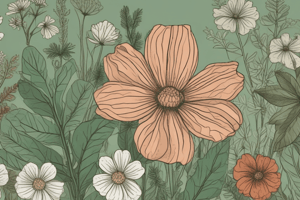Podcast
Questions and Answers
What is the common name of Matricaria recutita?
What is the common name of Matricaria recutita?
- Marshmellow
- Lemon Balm
- Chamomile (correct)
- Peppermint
Matricaria recutita is contraindicated in people with sensitivity to Asteraceae.
Matricaria recutita is contraindicated in people with sensitivity to Asteraceae.
False (B)
What is the family of Melissa officinalis?
What is the family of Melissa officinalis?
Lamiaceae
The Latin name of Peppermint is _______________________
The Latin name of Peppermint is _______________________
What is an indication of Mentha x piperita?
What is an indication of Mentha x piperita?
Match the following herbs with their families:
Match the following herbs with their families:
Melissa officinalis has antiviral properties.
Melissa officinalis has antiviral properties.
What is a caution of Matricaria recutita?
What is a caution of Matricaria recutita?
What is the main active constituent of Althea officinalis?
What is the main active constituent of Althea officinalis?
Glycyrrhiza glabra is contraindicated in patients with hypertension.
Glycyrrhiza glabra is contraindicated in patients with hypertension.
What is the common name of Ulmus rubra?
What is the common name of Ulmus rubra?
The family of Glycyrrhiza glabra is ___________.
The family of Glycyrrhiza glabra is ___________.
Match the following herbs with their respective families:
Match the following herbs with their respective families:
What is an indication for the use of Althea officinalis?
What is an indication for the use of Althea officinalis?
Glycyrrhiza glabra has anti-inflammatory properties.
Glycyrrhiza glabra has anti-inflammatory properties.
What is the Latin name of Golden seal?
What is the Latin name of Golden seal?
Flashcards are hidden until you start studying
Study Notes
Matricaria recutita (Chamomile)
- Belongs to the Asteraceae family
- Actions: carminative, mild sedative, vulnerary, antiulcer, anti-inflammatory, spasmolytic, mild bitter, mild astringent, and diaphoretic
- Indications: gastrointestinal spasm, IBS, flatulence, bloating, nervous dyspepsia, travel sickness, infantile colic, anxiety, restlessness, dysmenorrhoea, and amenorrhoea
- Topical uses: eczema, wound healing, and bacterial skin disease
- Cautions: people with sensitivity to Asteraceae should avoid oral and topical use; chamomile tea can reduce iron absorption
Melissa officinalis (Lemon Balm)
- Belongs to the Lamiaceae family
- Actions: carminative, relaxant, spasmolytic, mild sedative, diaphoretic, and antiviral (topically)
- Indications: sleep disturbances, restlessness, irritability, dyspepsia, flatulence, depression, and common cold
- Topical uses: herpes
- Contraindications: none known
Mentha x piperita (Peppermint)
- Belongs to the Lamiaceae family
- Actions: spasmolytic, carminative, cholagogue, antiemetic, antitussive, and mild sedative (internally); antimicrobial (both); analgesic and antipruritic (topically)
- Indications: dyspepsia, flatulence, chronic digestive problems, GIT spastics, gastritis, respiratory catarrh, common cold, nausea/morning sickness, and IBS
- Topical uses: headaches
- Contraindications: gastro-oesophageal reflux (lowers esophageal sphincter pressure)
- Cautions: may reduce iron absorption (take away from meals and supplements); may repress lactation
Althea officinalis (Marshmallow)
- Belongs to the Malvaceae family
- Main active constituent: mucilage
- Actions: demulcent, emollient, diuretic, vulnerary, expectorant, and antilithic
- Indications: diseases of mucous membranes, strangury and urinary issues, irritations of mucosa, dry cough, gastric/peptic/duodenal ulcer, and UTIs
- Topical uses: ulcers, wounds, eczema, and mouth inflammation (gargle)
- Interactions: absorption of other medications may be retarded
- Contraindications: none known
Glycyrrhiza glabra (Licorice)
- Belongs to the Leguminosae (Fabaceae) family
- Actions: anti-inflammatory, mucoprotective, demulcent, antiulcer, adrenal tonic, expectorant, antitussive, mild laxative, anti-cariogenic, and antiandrogenic
- Indications: gastric and duodenal ulcers, GORD, gastritis, PCOS, infertility, dysmenorrhoea, adrenal insufficiency, inflammatory conditions, upper respiratory catarrh, cough, and bronchitis
- Topical uses: eczema, melasma, mouth ulcers, and herpetic lesions
- Contraindications: cholestatic liver disorders, liver cirrhosis, hypertension, hypokalaemia, severe kidney insufficiency, and congestive heart failure
Ulmus rubra (Slippery Elm)
- Belongs to the Ulmaceae family
- Main active constituent: mucilage
- Actions: demulcent and emollient
- Indications: oesophagitis, colitis, peptic ulcer, gastritis, and diarrhoea
- Topical uses: boils, burns, and wounds
- Cautions: take away from other medication
Hydrastis canadensis (Golden Seal)
- Belongs to the Ranunculaceae family
- Actions: antihaemorrhagic, anticatarrhal, mucous membrane trophorestorative, antimicrobial, bitter tonic, and antibacterial
Studying That Suits You
Use AI to generate personalized quizzes and flashcards to suit your learning preferences.




